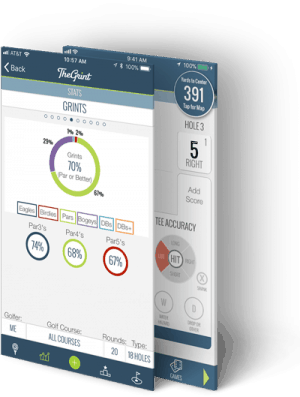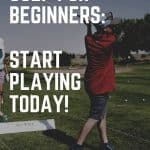1. Try It Out At The Practice Range
If you have never picked up a golf club before then the first place you should head to is your nearest driving range (also called a practice range). Make sure they have clubs available to borrow or rent before you go. Not all ranges do.
If it’s your first time at the range, just try to have some fun.
Start with some shorter shots. Starting right away with a full swing (especially with a driver) can be very frustrating. A lot of new players never get past this because they can’t make solid contact with the ball on a full swing.
Instead, take shorter swings. Try chipping the ball to nearby spots on the range. This will help you get comfortable making contact with the ball and let you feel what it’s like to feel a solid hit.
Once you feel comfortable with shorter swings, go ahead and try some longer swings.
When you are just starting, the majority of your practice (about 70-80%) should be with the shorter clubs.
2. Get A Starter Set Of Clubs
If your time at the driving range was successful, then you are ready to invest in some golf clubs.
For an in-depth guide on choosing golf clubs when you are just getting started, you can read our complete breakdown of the Best Golf Clubs For Beginners.
If you are looking for a great starter set check out our Callaway Strata Review. The Strata lineup is probably the best set for those of you getting started in the game.
There are a couple of things you want to be aware of before you go out and spend a lot of money on clubs.
First, as you improve, you’ll probably want to get better clubs. Golf club models are typically designed for a specific skill level. Beginner clubs are easier to hit straight and have a bigger sweet spot. Advanced clubs give you more control over the way the ball flies and curves through the air, but can be very difficult to use for beginners.

If you are just starting, then a starter set like the Callaway Strata is the way to go. That way you can get everything you need in a single, relatively affordable, package.
As you play more and want to take the next step up in club quality, look for clubs that say “game improvement.” These types of clubs are more durable and higher quality than a starter set, but have features that make it easier for beginners.
3. Get Comfortable Hitting Shots
Now that you have your own set of clubs that you can use regularly, it’s time to do some practicing.
You may want to run out to your local course right away, but a little bit of patience can be a huge benefit here. The single most common reason that new golfers give up the game is going out to the course without any practice and spending more time looking for stray shots than having fun.
If you want to progress faster with your practice sessions, you can CLICK HERE to get our free driving range practice guide.
Even professional golfers spend a lot more time on the practice range than they spend on the course.
As a beginner, the goal is to be able to hit the ball consistently in a relatively straight direction. Of course, you’ll have slices and hooks while you are learning, but a combination of practice and some lessons will help you work on that.
That being said, the practice range can get a little boring after a while. Luckily, there is an option that gets you out on a course but won’t be as frustrating. So up next…
4. Try A Short Course
Not all golf courses are created equal.
Some are really difficult and can be frustrating to play for even experienced and skilled golfers. So choose wisely.
Start off on a par 3 course. These are courses where all the holes are shorter. Sometimes they are called pitch and putt courses instead of par 3 courses.
After a few visits to the par 3 course, there is another type of course that is a little longer and will let you practice with more clubs in your bag (even the driver).
These types of courses are often called “executive courses.” These types of courses may have a mix of par 3, par 4, or even par 5 holes, but they are usually significantly shorter than a full-size course.
You should look for courses that are less than 5000 yards total for 18 holes (2500 yards for a 9 hole course).
If you can’t find shorter courses like this, start by playing the forward tees at any local course. Don’t get hung up on whether they are called “senior tees,” “women’s tees,” or something else. As a beginner, these are the tees where you should be starting.
5. Play 9 Holes (and then 18)
The first time you set foot on a full-length course can be intimidating.
There are two ways you can minimize some of that intimidating.
First, don’t reserve a tee time at 9 am on a weekend morning. The course will be crowded, there will be people watching you hit your tee shot on the first hole, and the course marshals will be driving around telling everyone to keep the pace of play up. Those are not good conditions for your first round of golf.
Instead, reserve a time later in the afternoon. Most golfers like to play in the morning and be back in the clubhouse having a beer by lunchtime. So if you start your round around 2 or 3 pm, then the course is more likely to be empty.
Second, don’t plan on playing all 18 holes your first time.
6. Keep Track Of Your Stats
Once you start playing on a regular basis, you will want to improve.
But you can’t improve your scores if you don’t know what your strengths and weaknesses are.
First of all, make sure you keep score accurately. A lot of beginners like to take mulligans when they mishit a shot and not count that in their score. Doing that will only prevent you from knowing how you are improving.
Keeping honest and accurate scores will actually help you improve faster. You’ll be able to see accurate results and progress.
In addition to keeping score, there are a few stats you should keep track of when you play.

The first is “greens in regulation” (“GIR”). This is how many times per round that you get the ball on the green in two strokes less than the par for that hole (one shot for a par 3, two shots for a par 4, and three shots for a par 5). As a beginner, you may not have any GIR at all in a round, but you’ll start getting some as you improve.
The next is when you hit the fairway with your tee shot. I also like to write down the club I used off the tee so I know if I am hitting more fairways with one club vs. the other.
The last one that you should keep track of is the number of putts you take on each green. You want to avoid taking more than 2 putts per hole on average. As a beginner, improving your putting is a great way to lower your scores.
The best way to keep track of these things while you’re playing is with a stat-tracking app on your phone. CLICK HERE to check out the one that I use every time I play.
7. Have Fun
Let’s face it, none of if are going to be playing for millions of dollars on the PGA Tour.
You are here to learn about the sport of golf so you can have fun playing with your friends.
While you’re learning the game, and once you improve and start playing more, don’t ever forget that this is a game and it should be fun. Golf can be frustrating, it can give you big highs and lows in a single round. You may have days when you want to throw your clubs into a lake (and I’ve seen players actually do that!).
Do your best not to let those days affect your enjoyment of the game.

